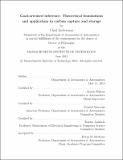| dc.contributor.advisor | Karen Willcox. | en_US |
| dc.contributor.author | Lieberman, Chad Eric | en_US |
| dc.contributor.other | Massachusetts Institute of Technology. Department of Aeronautics and Astronautics. | en_US |
| dc.date.accessioned | 2013-11-18T20:39:45Z | |
| dc.date.available | 2013-11-18T20:39:45Z | |
| dc.date.copyright | 2013 | en_US |
| dc.date.issued | 2013 | en_US |
| dc.identifier.uri | http://hdl.handle.net/1721.1/82472 | |
| dc.description | Thesis (Ph. D.)--Massachusetts Institute of Technology, Dept. of Aeronautics and Astronautics, 2013. | en_US |
| dc.description | This electronic version was submitted and approved by the author's academic department as part of an electronic thesis pilot project. The certified thesis is available in the Institute Archives and Special Collections. | en_US |
| dc.description | Cataloged from department-submitted PDF version of thesis. | en_US |
| dc.description | Includes bibliographical references (p. 127-132). | en_US |
| dc.description.abstract | Many important engineering problems require computation of prediction output quantities of interest that depend on unknown distributed parameters of the governing partial differential equations. Examples include prediction of concentration levels in critical areas for contamination events in urban areas and prediction of trapped volume of supercritical carbon dioxide in carbon capture and storage. In both cases the unknown parameter is a distributed quantity that is to be inferred from indirect and sparse data in order to make accurate predictions of the quantities of interest. Traditionally parameter inference involves regularization in deterministic formulations or specification of a prior probability density in Bayesian statistical formulations to resolve the ill-posedness manifested in the many possible parameters giving rise to the same observed data. Critically, the final prediction requirements are not considered in the inference process. Goal-oriented inference, on the other hand, utilizes the prediction requirements to drive the inference process. Since prediction quantities of interest are often very low-dimensional, the same ill-posedness that stymies the inference process can be exploited when inference of the parameter is undertaken solely to obtain predictions. Many parameters give rise to the same predictions; as a result, resolving the parameter is not required in order to accurately make predictions. In goal-oriented inference, we exploit this fact to obtain fast and accurate predictions from experimental data by sacrificing accuracy in parameter estimation. When the governing models for experimental data and prediction quantities of interest depend linearly on the parameter, a linear algebraic analysis reveals a dimensionally-optimal parameter subspace within which inference proceeds. Parameter estimates are inaccurate but the resulting predictions are identical to those achieved by first performing inference in the full high-dimensional parameter space and then computing predictions. The analysis required to identify the parameter subspace reveals inefficiency in experiment and sources of uncertainty in predictions, which can also be utilized in experimental design. Linear goal-oriented inference is demonstrated on a model problem in contaminant source inversion and prediction. In the nonlinear setting, we focus on the Bayesian statistical inverse problem formulation where the target of our goal-oriented inference is the posterior predictive probability density function representing the relative likelihood of predictions given the observed experimental data. In many nonlinear settings, particularly those involving nonlinear partial differential equations, distributed parameter estimation remains an unsolved problem. We circumvent estimation of the parameter by establishing a statistical model for the joint density of experimental data and predictions using either a Gaussian mixture model or kernel density estimate derived from simulated experimental data and simulated predictions based on parameter samples from the prior distribution. When experiments are conducted and data are observed, the statistical model is conditioned on the observed data, and the posterior predictive probability density is obtained. Nonlinear goal-oriented inference is applied to a realistic application in carbon capture and storage. | en_US |
| dc.description.statementofresponsibility | by Chad Lieberman. | en_US |
| dc.format.extent | 132 p. | en_US |
| dc.language.iso | eng | en_US |
| dc.publisher | Massachusetts Institute of Technology | en_US |
| dc.rights | M.I.T. theses are protected by
copyright. They may be viewed from this source for any purpose, but
reproduction or distribution in any format is prohibited without written
permission. See provided URL for inquiries about permission. | en_US |
| dc.rights.uri | http://dspace.mit.edu/handle/1721.1/7582 | en_US |
| dc.subject | Aeronautics and Astronautics. | en_US |
| dc.title | Goal-oriented inference : theoretical foundations and application to carbon capture and storage | en_US |
| dc.type | Thesis | en_US |
| dc.description.degree | Ph.D. | en_US |
| dc.contributor.department | Massachusetts Institute of Technology. Department of Aeronautics and Astronautics | |
| dc.identifier.oclc | 862119423 | en_US |
